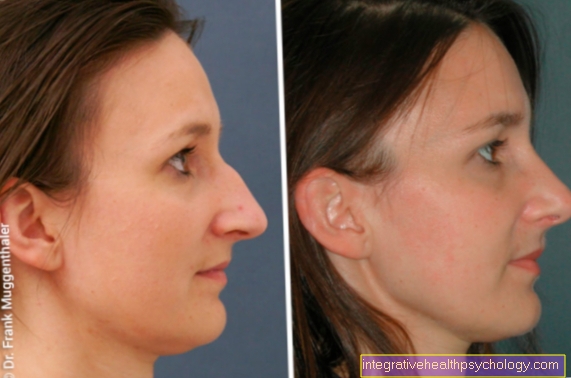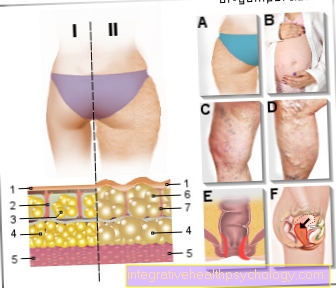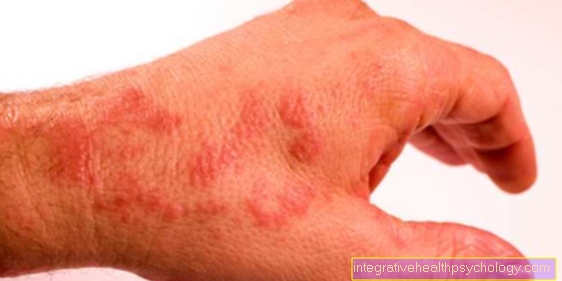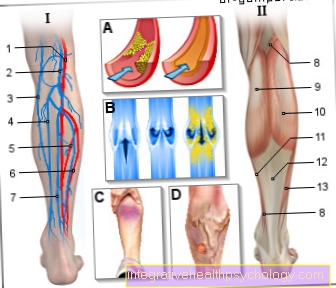Granuloma annulare
definition
The so-called granuloma annulare is a benign skin lesion that occurs mainly in adolescents and young adults.
It mainly affects women.
In general, it is a rare condition that affects the backs of the hands and feet in particular.
Knotty, circularly arranged skin changes that are raised above the skin level are typical.
The skin-colored changes in the skin, also known as papules, do not cause itching or pain.
They are symptom-free and spread centrifugally, i.e. from the inside out.
They heal from their center, so that they temporarily have a small crater.
The cause of the disease is unclear.
Granuloma is a type of tissue proliferation that is characterized by the appearance of special cells (epithelial cells, giant cells).
At this point in time, however, it is not known why these granulomas develop.
The backs of the hands and feet are the most common locations, but the granuloma annulare can also occur in other parts of the body.
Treatment of the granuloma annulare is not absolutely necessary as it often resolves on its own.
Treatment options include freezing (cryotherapy) and the injection of cortisone (glucocorticoids) into the granuloma.

Causes of Annular Granuloma
The exact causes of granuloma annulare are not known. Presumably several factors contribute to its development.
It is noticeable that diabetes mellitus is observed in over 10% of patients.
A disorder of lipid metabolism in the form of high cholesterol or fat levels in the blood is even found in almost half of patients with granuloma annulare.
Symptoms of granuloma annulare
The granuloma annulare is noticeable by ring-shaped, coarse nodules on the skin that are skin-colored to slightly reddish, but usually do not cause itching.
They usually appear on the back of the feet and hands, often above the joints and can be up to the size of a coin.
As the disease progresses, the papules expand and can enlarge. The lower legs, forearms, face and the trunk of the body can also be covered with papules. The disease is often intermittent and is characterized by frequent recurrences.
The granuloma annulare can appear similar to rheumatoid nodules, so it is very important to distinguish it.
Certain forms of sarcoid, a connective tissue disease, should also be excluded. If the papules are localized, it should be determined whether it is a skin reaction due to a foreign body.
The symptoms usually go away on their own and the papules heal without scarring.
Granuluma annulare disseminatum
A Special shape des Granuloma annulare is the so-called Granuloma annulare disseminatum. This is characterized by reddish to brown rough noduleswho found out about the entire body spread. The face is often left out.
The granuloma annulare disseminatum occurs predominantly in the Adulthood up and is through one lengthy course marked, which may drag on for up to 10 years.
Spontaneous healing occurs significantly less often with this special form than with the clinical picture of a granuloma annulare with a normal course of the disease.
Especially often people are affected who have a HIV infection exhibit.
The first therapeutic approach for granuloma annulare disseminatum is local treatment cortisone creams.
Often, however, this does not and should not provide sufficient improvement systemic therapy to be started. It usually starts with a so-called PUVA therapy. Here, a cream is first applied to the affected areas and then targeted with UVA light irradiated. The treatment usually lasts for several months. But creams with cortisone as an active ingredient can also help.
A systemic approach is the therapy with fumaric acid esters in tablet form.
Does a granuloma also develop with Lyme disease?
In the so-called Lyme borreliosis, which is transmitted by ticks, a skin reaction occurs as a reaction to the tick bite, which is very similar to the clinical appearance of granuloma annulare.
The first stage of Lyme disease is known as erythema annulare. What is meant here is a ring-shaped reddening that usually occurs around the bite site, but is not raised.
In contrast, the granuloma annulare forms raised papules that bulge noticeably out of the skin.
Another difference is that the papules in granuloma annulare are usually more frequent, whereas in Lyme disease there is a reddened ring that spreads increasingly. In rare cases, Lyme disease can cause reddening that is spread over the body. Then it is important to confirm or exclude borreliosis through special examinations.
Read more about the topic here: Lyme disease
What is a foreign body granuloma?
Foreign body granulomas arise as a kind of inflammatory reaction of the skin, the soft tissue and the subcutaneous fat tissue to the penetration of foreign bodies.
This is a chronic inflammatory reaction that causes the giant cells typical of granulomas.
Possible foreign bodies are, for example, non-removed skin threads, spines, antiperspirants or even hair.
Medicinal substances such as collagens (dermatological treatments with fillers) can also cause a foreign body granuloma.
Contrary to what the name suggests, however, the body's own substances can also be responsible for the development of a foreign body granuloma.
Diseases such as gout or adipose tissue inflammation are possible causes.
The reddish-brown, coarse nodules can appear all over the body and cause sharp pain.
The foreign body and the inflamed granuloma are surgically removed by a surgeon.
Glucocorticoids, which are similar to cortisone, are also injected into the tissue.
They inhibit the inflammatory reaction and thus contribute to healing.
Casing granuloma of tuberculosis
Tuberculosis is an infectious disease caused by so-called mycobacteria.
It can affect almost any organ - including the skin - and is a granulomatous disease.
Typical of tuberculosis is the development of so-called casing granulomas.
This type of granuloma is characterized by the fact that necrosis is found in them.
Necroses are nests of dead cells, which in tuberculosis are often in the center of the granuloma.
These casing granulomas can be seen by pathologists under a microscope and thus consider tuberculosis as a disease.
The granulomas themselves can be found in any organ, but are very often found in the lungs.
Read more about this infectious disease in our article:
Tuberculosis - these are the causes
Granulomas of the skin - how can they develop?
First of all, granulomas are nothing more than a special type of tissue proliferation.
They are part of various diseases and can also affect the skin.
In the context of chronic inflammation, for example in tuberculosis, rheumatism, sarcoid or fatty tissue inflammation, granulomas are found on the skin.
A foreign body, such as a sting or a non-removed skin suture, can also cause granuloma of the skin.
The granuloma can be felt as a rough skin lump.
It does not necessarily cause symptoms and often has no special discoloration, but is skin-colored.
The type of granuloma is determined by a sample and further tests that are tailored to the underlying clinical picture.
Granuloma on the lip
Various granulomas can be found on the lip.
Overall, granulomas in this location are very rare, but they can occur as part of an underlying disease, for example tuberculosis.
A foreign body can also cause a granuloma here.
These granulomas are called foreign body granulomas.
Such a foreign body granuloma on the lip can also arise as a complication of medical injections as part of a filler treatment.
The rheumatic granuloma
Granulomas can also occur in the context of rheumatism.
They are found primarily on the extensor sides of the forearms, but also on the elbows, hands, backs of the fingers and behind the ears (retroauricular region).
Rheumatic granulomas are skin-colored, hard nodules that are not painful.
They can be up to the size of a hazelnut and are easy to feel.
Such granulomas are found in up to 20% of those affected who suffer from rheumatism.
The rheumatoid nodules can be surgically removed or treated with injections containing a glucocorticoid solution.
However, the focus is on treating the underlying disease, namely rheumatism.
You can find more information about rheumatism at:
Rheumatism - Everything You Should Know
Can a granuloma develop on the nose?
Granulomas can also develop on the nose for various reasons.
One possible cause is the granuloma faciale.
This is a harmless, mostly chronic, skin disease, the cause of which is not known.
The disease is very rare and mainly affects the nose, but also the chin, forehead and cheeks.
Typical are red-brown nodules, about 0.5 to 2 cm in size, which can appear individually or in groups.
These types of granulomas rarely heal on their own and then mostly cause scars.
One therapeutic option is to take the drug Dapsone.
Cortisone injections or surgical removal are also possible.
Therapy of the granuloma annulare
In many cases the granuloma annulare regresses by itself. This is especially the case with children and can take a few months for the tough nodules to heal without scars.
If this is not the case, especially in adults, cortisone-containing creams can be used, which are often covered with a film bandage.
Find out more about the topic here Cortisone ointment
Another option is what is known as cryotherapy. This is a local cold therapy.
If this does not have a sufficient effect, systemic therapy may be necessary. Antimalarials have been shown to be effective and can be taken as tablets for 4 to 8 weeks. Tablets with fumaric acid esters also often lead to a cure (for example Fumaderm®).
There are also homeopathic treatment approaches. The ingestion of thuja in a high potency is said to aid healing. For this, Thuja can be taken as globules with a potency of 20000 at intervals of 2 to 3 weeks. Conium or Silicea are also said to be helpful in curing the skin disease.
Find out more about the topic here Thuja occidentalis
cure
In many cases, especially in children, heals the Granuloma annulare on its own.
In adults, on the other hand, therapy is often necessary to make the rough nodules disappear again.
The papules almost always heal without scarring out. However, it is possible that the granuloma annulare will reappear some time after it has healed.
The Granuloma annulare disseminatum goes as a special form less often spontaneously and back without treatment. Even local therapy with creams is often not enough to achieve freedom from symptoms.
However, the granuloma annulare disseminatum can usually be treated well through the systemic administration of medication. Here it can however, to scarring come.
Further topics from this area

skin rash
A rash can be caused by a number of reasons. These can be harmless causes that lead to a rash or serious skin conditions.
Here you get to the topic: skin rash

Rash without itching
There are several causes for a rash to appear without itching. Above all, accompanying complaints can provide important information.
Here you get to the topic: Rash without itching





























